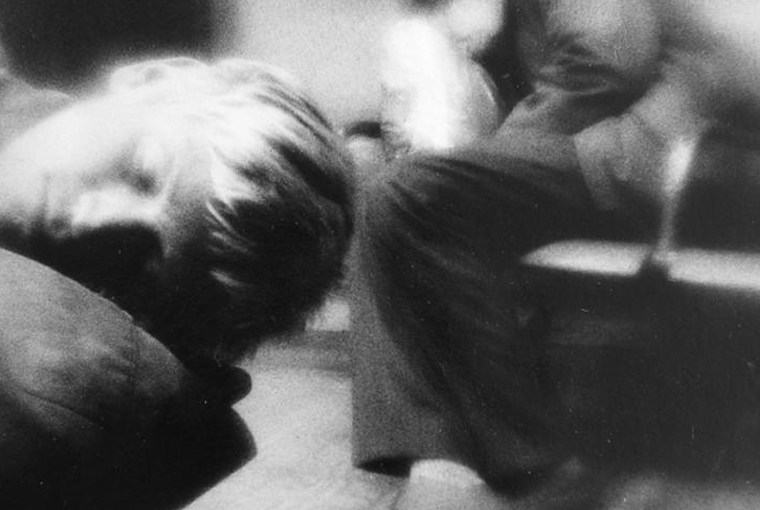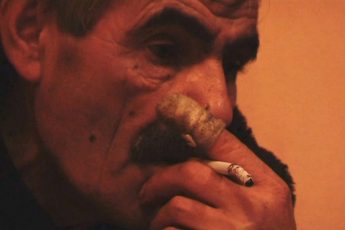Past and Present
Sergei Loznitsa’s Segodnya My Postroim Dom (1996), Zhizn, Osen (1998), Polustanok (2000)
Vol. 16 (April 2012) by Moritz Pfeifer
Sergei Loznitsa’s early films are strange attempts at capturing everyday life. Shot in the late nineties and early tens, they seem to belong to a far more distant period.
Nothing in his first film Today We Are Going to Build a House, which depicts a day of workers building a house, hints at a prosperous reconstruction period. Indeed, after the collapse of the Soviet Union, housing construction radically declined throughout the 1990s and only prospered in 2001 with Russia’s economical situation rising. So Loznitsa’s 1994 construction site is empty, the workers old, and the progress stalling. Wooden rooftops, antique tin buckets, and the preferred use of hands and ropes instead of machines indicate an outdated working-style. But there is also something quite comical about this film, perhaps most apparent in its use of sound and music. Loznitsa keeps away from dialogues but the (intentional?) use of unreal sound effects add something of a slapstick character to some of the scenes. In one scene a worker climbs up a crane each of his footsteps producing a loud cling on the metal. The authoritative sound seems like an encouragment but reverberates as ironic commentary regarding the general immobility of the workers.
His third film, The Train Stop, develops on the theme of stagnation. The film depicts a crowd of exhausted people sleeping in a train station waiting to continue their journey. This film is even harder to situate in a certain epoch. Shot during the millennium, the film could easily pass for 1920s Russian avantgarde. While the camera patiently gazes over the snoring crowd, the blurry images adapt to the gathering’s general repose. Today We Are Going to Build a House was shot from a distant neither granting access to the dialogues of the workers nor to a close view of their faces. In The Train Stop Loznitsa infiltrates his field of study, but in both films he remains unseen. This distance adds to the impression that what is happening is faraway.
Even if both films touch at the past, Loznitsa effectively avoids nostalgia. Unlike many of his contemporaries, these films might be timeless, but they lack the underlying persuasion that there were better days. Perhaps this can be explained because the anachronism portrayed in his films seems more real than imagined. Loznitsa doesn’t project imaginations of the future unto past events. The people he films are real because the situations they are in are so banal that applying any ideology to them wold seem like an over-interpretation. It feels wrong to look at his sleeping crowd through the lens of post-Communism and lament about the inhuman conditions of the overworked poor.
His second film is perhaps less distant. Life, Autumn (1999) that was co-directed, along with his first film, with Marat Mgambetov, a colleague from film school, uses more close-ups. Life, Autumn is set in a small village near the city of Smolensk. Like in his other films, time in this film seems distant – a pig is slaughtered in front of a house with a knife, and the numerous scenes of nature give the feeling that things always repeat themselves here. But unlike his other two films, that also convey this repetitive feeling, circularity is broken because the peasants are the last ones left. There are no young people in this movie, the offspring has moved to the cities, leaving ancestors and their customs behind. Ultimately this changes the atmosphere of the film. The faces of the old peasants look sad. Their wrinkles hold memories threatened to become forgotten.
Life, Autumn is the only film in the series that establishes a link between past, present and future keeping alive a nostalgic perspective, with something like a harmonious past, a vulnerable present and an absent future. Although the film’s images are at least as striking as those of the other two, in its outlook on time Life, Autumn appears to be the weakest one. The other two are almost unique attempts to capture the naked present. If that present seems past, the reasons for that can be found in the present not in the director’s fondness for things past. The over-descriptive titles – Today We Are Going to Build a House, and Train Stop reflect this care for reality. These titles don’t need the word “life” to speak of existence.




Leave a Comment